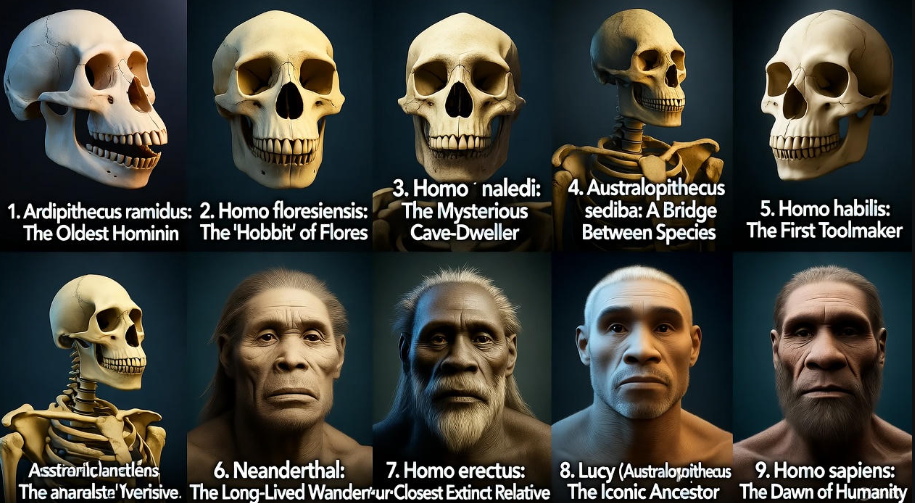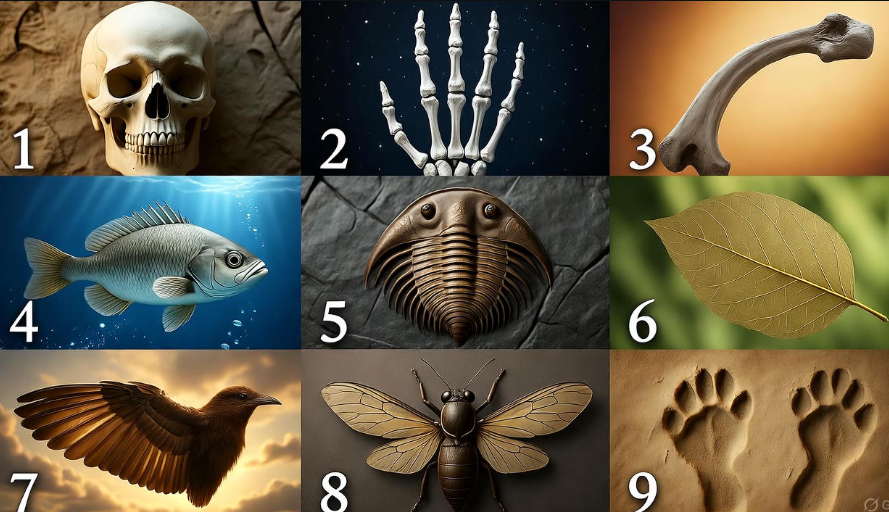Human history is like a giant puzzle 🧩 — and every now and then, a single fossil can flip the entire picture upside down. From mysterious skulls to ancient footprints, fossils have told us stories that no history book ever could. Over the past century, scientists have uncovered discoveries that forced us to rethink how we evolved, migrated, and even how we lived thousands — sometimes millions — of years ago. Let’s walk through nine remarkable fossil finds that completely rewrote what we thought we knew about our own story.
1. The Taung Child — The First Clue We Walked Upright
In 1924, a small skull was found in South Africa by a quarry worker. At first glance, it looked like that of a child — but not quite human. Raymond Dart, an anatomist, studied it closely and realized it belonged to Australopithecus africanus, a species that lived nearly 2.8 million years ago.
What made it special? The skull’s position showed that this species walked upright long before we thought humans could. Before this find, scientists believed our ancestors first developed big brains, then learned to walk. The Taung Child proved the opposite — walking came first, and brains evolved later.
| Key Fact | Detail |
|---|---|
| Discovered | 1924, South Africa |
| Species | Australopithecus africanus |
| Age | Around 2.8 million years |
| Importance | Proved early bipedalism (upright walking) |
2. Lucy — The World’s Most Famous Early Human
Fast forward to 1974. In Ethiopia, paleoanthropologist Donald Johanson and his team discovered 40% of a skeleton that would become one of the most famous fossils in history — “Lucy.”
She belonged to Australopithecus afarensis, an ancestor that lived about 3.2 million years ago. Lucy stood only 3.5 feet tall, but her bones revealed something groundbreaking: she walked on two legs — like us. Yet her brain was still small, showing a transitional stage between apes and humans.
When scientists realized she could walk upright, it completely changed how we viewed the timeline of evolution. Lucy wasn’t just a fossil; she was a bridge between species.
3. The Neanderthal Skeletons — Redefining “Primitive” Humans
In 1856, miners in Germany’s Neander Valley discovered bones that looked oddly human but not quite. These were the first recognized Neanderthal fossils. Initially, scientists thought they represented a brutish, unintelligent race.
But new studies told a very different story. Neanderthals were intelligent, made tools, buried their dead, and even had symbolic art. DNA analysis later proved that modern humans share some of their genes — meaning many of us carry Neanderthal ancestry today!
This discovery completely changed the image of our ancient cousins. They weren’t primitive monsters; they were humans, too — just a different kind. 🧬
| Discovery Year | 1856 |
|---|---|
| Species | Homo neanderthalensis |
| Key Insight | Neanderthals had culture, tools, and mixed with modern humans |
4. The Homo Floresiensis — The “Hobbit” of Indonesia
In 2003, deep inside a cave on the Indonesian island of Flores, scientists found something unexpected — the bones of a tiny human species only about 3 feet tall!
Nicknamed “The Hobbit,” Homo floresiensis lived as recently as 50,000 years ago. What made it shocking was that this species had a very small brain yet made tools and hunted animals.
The find proved that small-brained humans could survive and adapt successfully, even alongside larger-brained species like us. It also suggested that evolution didn’t follow one straight path — there were many branches, some still waiting to be discovered.
5. Laetoli Footprints — The Oldest Human Footprints
Sometimes, it’s not bones but footprints that tell the story. In 1978, in Tanzania’s Laetoli region, Mary Leakey’s team found a trail of footprints preserved in volcanic ash. They were about 3.6 million years old — and clearly made by creatures walking upright.
These prints matched the feet of Australopithecus afarensis, the same species as Lucy. It was like finding a photograph frozen in stone, showing two (possibly three) individuals walking side by side.
It gave direct, physical proof that our ancestors were walking upright long before we developed modern human features. 👣
| Location | Laetoli, Tanzania |
| Discovery | 1978 |
| Age | 3.6 million years |
| Significance | First direct evidence of bipedal walking |
6. Turkana Boy — The Teen Who Showed Our Growth Pattern
In 1984, in Kenya near Lake Turkana, a nearly complete skeleton of a young boy was discovered — later called Turkana Boy. He belonged to Homo erectus and was about 1.6 million years old.
What amazed scientists was how human-like his body was — long legs, narrow hips, and an upright posture. He looked like a modern teenager, showing that Homo erectus had already developed the body plan for endurance walking and running.
He also revealed insights into growth — Homo erectus children grew faster than modern human kids, suggesting that longer childhoods evolved later with Homo sapiens.
7. Denisovans — The Ghost Relatives Found in a Finger Bone
In 2010, a tiny finger bone found in Denisova Cave, Siberia, seemed unimportant — until scientists tested its DNA. The results revealed an entirely new branch of human relatives: the Denisovans.
No one had ever seen them before. They lived around the same time as Neanderthals and early humans, yet their genes still exist in people from Asia and the Pacific today.
This discovery changed the understanding of human evolution’s complexity — proving that at one point, at least four different human species lived and interbred on Earth simultaneously. 🌍
| Discovery Year | 2010 |
| Species | Denisovans (unnamed species) |
| Discovery Site | Denisova Cave, Siberia |
| Impact | Revealed new human species and interbreeding with humans |

8. Ardipithecus Ramidus — The Earliest Known Ancestor
Before Lucy, there was Ardi. In 1994, scientists in Ethiopia discovered a partial skeleton of Ardipithecus ramidus, dated around 4.4 million years old.
Ardi walked on two legs but also climbed trees — showing a unique transition between apes and early humans. Her discovery pushed back the timeline of bipedalism even further than Lucy’s.
The fossil also revealed that early human ancestors didn’t evolve from aggressive, chimp-like creatures but from more peaceful ones — changing the story of our social evolution as well.
9. The Rising Star Cave Discovery — Homo Naledi’s Mystery
In 2013, inside South Africa’s Rising Star cave system, researchers uncovered over 1,500 fossils belonging to a new species — Homo naledi.
The strange part? The bones were placed deep inside a narrow chamber that required crawling through tight spaces to reach. This suggested deliberate burial — a behavior thought to be exclusive to modern humans.
The twist? Homo naledi had a small brain, about one-third the size of ours. How could such a small-brained species show such complex behavior? That question still puzzles scientists today. 🤯
| Discovery Year | 2013 |
| Species | Homo naledi |
| Location | Rising Star Cave, South Africa |
| Key Insight | Possible ritual behavior despite small brain size |
What These Fossils Teach Us About Being Human
All these discoveries share a single truth — human evolution is not a straight line. It’s a web. Different species lived, evolved, and sometimes even coexisted. Some adapted to harsh climates, others developed tools or social behavior, and some simply vanished.
The story of humanity is one of survival, creativity, and constant change. Every fossil adds a new piece to that puzzle, reminding us how connected we are to every form of life that came before.
| Evolutionary Lesson | What We Learned |
|---|---|
| Walking came first | Intelligence evolved later |
| Many species coexisted | Evolution isn’t a single path |
| Culture existed early | Burial and art appeared before Homo sapiens |
| Genes don’t lie | DNA links us to Neanderthals and Denisovans |
Frequently Asked Questions (FAQs)
Q1: Which fossil is considered the most important in human evolution?
Lucy (Australopithecus afarensis) is often seen as the most important because she clearly showed that humans walked upright millions of years before developing big brains.
Q2: How do scientists know how old fossils are?
They use methods like radiometric dating, carbon dating (for younger fossils), and studying the layers of earth (stratigraphy) where fossils are found.
Q3: Are there still unknown human species waiting to be discovered?
Absolutely! New DNA technology and ongoing digs in Africa and Asia suggest there are still undiscovered branches in our family tree.
Q4: Do modern humans still have DNA from ancient species?
Yes. People from Europe have about 1–2% Neanderthal DNA, while some populations in Asia and Oceania carry Denisovan DNA.
Q5: What do these discoveries mean for our future?
They remind us that humans are adaptable. We’ve faced climate shifts, extinctions, and survival challenges — and each time, we’ve evolved and thrived. Understanding our past helps us face the future with perspective.
Final Thoughts
Every fossil tells a whisper of the past — a story buried in stone for millions of years. From Lucy’s tiny frame to the Hobbit’s surprising intelligence, these fossils show that humanity didn’t emerge overnight. It evolved through countless experiments by nature.
And that’s the beauty of it — each new discovery doesn’t close the book on human history. It opens another chapter. 🌍🦴

Leave a Reply